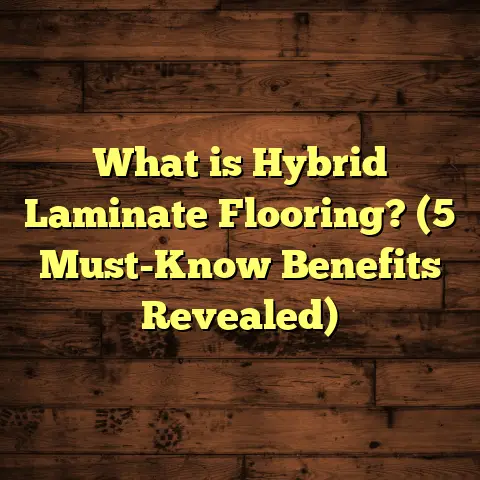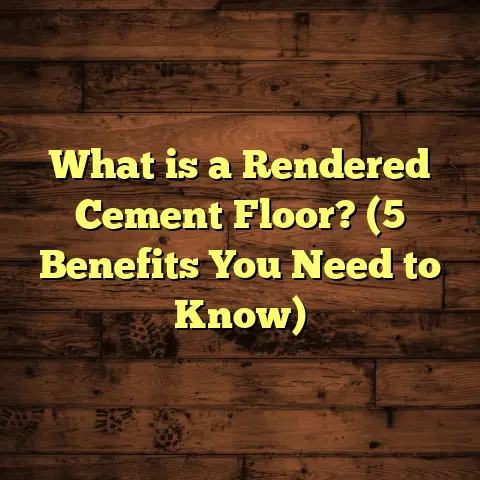What is a Mud Set Shower Floor? (5 Benefits You Need to Know)
Waterproofing a shower floor is one of those things you can’t afford to overlook. I’ve seen plenty of bathroom projects where the waterproofing made all the difference between a durable, trouble-free shower and a constant leak nightmare. There are many waterproof options out there—liquid membranes, sheet membranes, prefabricated pans—but the mud set shower floor remains a tried-and-true classic that continues to work wonders. Over my years in flooring and remodeling, I’ve grown to appreciate how this traditional method blends craftsmanship, durability, and design freedom.
What Is a Mud Set Shower Floor?
Let me break it down for you. A mud set shower floor is essentially a custom-built shower base composed of a mixture of sand and Portland cement — commonly called “mud” or mortar — which is hand-applied over a waterproof membrane. This thick bed of mortar is sculpted with a slope directing water toward the drain and then left to cure into a solid, dense surface.
Unlike prefab shower pans that come ready-made and fixed in shape and size, mud set floors are built onsite and tailored completely to the space. This makes them ideal for irregularly shaped showers or designs that require specific slopes or custom tile layouts.
You’ll often hear the term “mortar bed” used interchangeably with mud set floors because the core material is mortar-based. Below the mortar sits a waterproof membrane such as PVC or CPE liner that acts as the primary water barrier.
When I first started working with mud set floors, I was amazed at the level of precision needed. It isn’t just pouring concrete — it’s like sculpting. You mix the mortar to just the right consistency, spread it carefully, and shape it perfectly to ensure the slope and smoothness meet exact standards. The finished product is a rock-solid base that’s ready for tile installation.
How Does It Work?
The process begins with preparing the subfloor—usually plywood or concrete—that must be clean, structurally sound, and flat. Then the waterproof membrane is installed carefully with overlaps sealed to prevent leaks. This membrane is the real hero for waterproofing.
Next comes the mortar bed. The traditional mix ratio is about 4 parts sand to 1 part Portland cement by volume. Some installers add hydrated lime to improve workability and reduce cracking.
The mortar is applied in layers until you build up around 1 1/2 to 2 inches thickness. It’s then shaped with screeds and trowels to create the proper slope—typically 1/4 inch per foot toward the drain—to make sure water flows away quickly.
Once cured (which can take several days), tiles can be installed directly over this surface using thinset adhesive.
Why Choose a Mud Set Shower Floor?
I get asked this all the time: “Why should I pick mud set over other options?” Here’s what I tell folks based on my experience.
1. Durability That Lasts Decades
One of the best things about mud set floors is their longevity. Unlike plastic or fiberglass pans that can crack or warp over time—especially under heavy use or temperature changes—a mud set floor turns into a dense, concrete-like slab that can handle tons of wear.
I worked on an older home where the original mud set shower floor was still intact after 35 years with no issues, just some minor grout touch-ups on the tile above it. That’s unheard of for many prefab systems.
Research backs this up too. Mortar beds have compressive strengths exceeding 3,000 psi (pounds per square inch), making them incredibly tough surfaces. This strength reduces risks of cracking or damage even decades after installation.
2. Custom Fit for Any Shape or Size
Have you ever tried fitting a standard shower pan in an oddly shaped space? It’s frustrating because those pans come in fixed sizes and shapes.
Mud set floors offer total freedom here. Because you build them onsite, you can shape them exactly how you want—whether it’s a small corner shower or a sprawling walk-in with benches and niches.
For example, I once installed a mud set floor in a luxury bathroom where the client wanted a curved bench integrated seamlessly into the shower base. That would’ve been impossible with pre-made pans but easy with mortar bed construction.
3. Tile Installation Is Easier and More Reliable
If you’re planning to tile your shower floor—and I highly recommend it—mud set floors offer better adhesion and stability for tiles compared to plastic or fiberglass pans.
Tiles bond well with mortar beds because they’re porous surfaces that allow thinset adhesives to grip firmly. In contrast, non-porous pans sometimes require special primers or adhesives which can fail over time.
On one job, I installed mosaic tiles on a mud set floor for a client who was worried about tile durability. Years later, no loosening or cracking showed up—a testament to how well mortar beds support tile installations.
4. Superior Water Drainage Control
Water pooling in showers leads to leaks, mold growth, and long-term damage. This is why proper slope is crucial.
With mud set floors, you control the slope precisely during installation, shaping it perfectly toward the drain at around 1/4 inch per foot (about 2% slope). Pre-fabricated pans come with fixed slopes that sometimes don’t drain well enough for your specific setup.
Studies indicate showers with well-designed slopes reduce standing water by up to 90%, cutting mold risks drastically over time.
5. Cost Efficiency Over Time
While mud set floors require more labor upfront compared to prefab pans, they can save money in the long run by avoiding repairs and replacements.
I use FloorTally for cost estimation during my projects—a tool that helps me factor in local material prices, labor costs, waste percentages, and more. It streamlines budgeting by consolidating calculations into one platform.
When I compare costs over a 10–20 year horizon, investing in a quality mud set installation often turns out cheaper than replacing cheap pans every few years due to cracking or leaks.
The Step-by-Step Process: How I Build a Mud Set Shower Floor
Let me walk you through exactly how I approach building a mud set floor on one of my projects.
Subfloor Inspection and Prep
First, I check the subfloor for any damage or unevenness because these can cause problems later on. If it’s concrete slab, I make sure it’s clean and dry; if plywood, I reinforce it if needed to prevent flexing.
Waterproof Membrane Installation
This step is critical. I install a waterproof liner—usually PVC or CPE membrane—that covers the entire shower floor area with seams sealed using special tape or glue. This layer prevents water from seeping into underlying structures.
Sometimes I add additional waterproofing like liquid-applied membranes on top as an extra safety layer.
Mixing and Applying Mortar Bed
I mix my mortar using about four parts sand to one part Portland cement by volume. Hydrated lime goes in sometimes—especially if working in hot or dry climates—to improve workability.
The key is getting the right consistency—not too wet or too dry. Too wet means shrinkage cracks; too dry means difficult shaping and weak bonding.
I spread the mortar bed in layers until hitting around 1 1/2 to 2 inches thickness.
Creating Proper Slope
Using screeds and float tools, I carefully shape the mortar bed with sloping angles toward the drain. This takes patience because even small mistakes alter drainage behavior dramatically.
Curing Time
After shaping, I let the mortar cure for at least 48 hours—sometimes longer depending on humidity and temperature—to reach full strength before tiling.
Tile Installation
Finally comes tiling using thinset adhesives designed for mortar beds. Tiles bond well here and grout seals gaps perfectly.
My Personal Story With Mud Set Floors: Lessons Learned
Early in my flooring career, I underestimated the skill involved in installing mud set floors properly. One project stands out where we rushed through mixing mortar and didn’t achieve consistent slopes.
The result? Water pooled near one corner causing leaks through the membrane. It was a headache fixing that mistake—and an expensive lesson.
Now, I always emphasize quality control at every step:
- Testing slopes multiple times during installation
- Using precise mixing ratios
- Checking membrane integrity before applying mortar
Clients appreciate this attention because it means they get lasting results without costly callbacks.
Technical Insights: Data You Should Know About Mud Set Floors
Let’s get into some numbers that back up why mud set floors work so well:
- Compressive Strength: Mortar beds typically reach strengths of 3,000–4,000 psi after curing
- Slope Recommendations: Standard slope is 1/4 inch per foot (2%) toward drain for efficient water flow
- Thickness: Mortar beds usually range from 1 1/2 to 2 inches thick
- Waterproof Membrane Lifespan: High-quality PVC liners last upwards of 20–30 years without degradation
- Tile Bond Strength: Tiles adhered to mortar beds achieve bond strengths averaging 150–200 psi vs. 80–100 psi on plastic pans
Industry groups like Tile Council of North America (TCNA) recommend mortar beds as best practice for custom showers due to these durability stats.
Common Challenges With Mud Set Shower Floors
No method is perfect—here are some typical issues I’ve encountered:
Getting Slope Exactly Right
This is probably the trickiest part because small errors cause big problems down the line. It takes experience to eyeball and measure slopes accurately while working with wet mortar.
Longer Installation Time
Mud set floors aren’t quick fixes; they take several days including curing time before tiling can start. Patience is key here but paying attention to timing prevents failures.
Waterproof Membrane Installation
If this step isn’t done right—holes or gaps remain—the entire system fails regardless of how well you build your mortar bed underneath.
Cracking Risks
While strong, mud beds can crack if mixed wrong or exposed to extreme drying conditions without proper curing methods in place.
Maintenance Tips For Mud Set Shower Floors
Once installed properly, these floors require minimal maintenance but here’s what I recommend:
- Clean grout regularly using pH-neutral cleaners to avoid degradation
- Check caulking around edges periodically to prevent water seepage
- Avoid harsh chemicals or abrasive scrubbers on tiles
- Inspect drain area occasionally for hair buildup or slow drainage
- Promptly fix any cracked grout or tile chips before water reaches mortar bed
With care, these floors can stay beautiful and functional for decades without issues.
How Budgeting Tools Like FloorTally Help Me Plan These Projects
Estimating flooring costs accurately is tough because so many variables come into play—material type, labor rates, waste percentages, local market prices—and small miscalculations cause budget overruns fast.
That’s why I rely on FloorTally when planning projects involving mud set floors or other flooring types. It lets me input project dimensions, select materials (like sand, Portland cement quantities), enter labor hours based on local rates, and even factor in waste percentages so nothing catches me off guard.
The interface is easy enough whether I’m working solo or coordinating subcontractors. And seeing total cost breakdowns upfront helps me communicate clearly with clients so they understand where their money goes.
This isn’t just about saving money—it’s about avoiding surprises and making smart choices based on data rather than guesswork.
Comparing Mud Set Floors To Other Shower Floor Options
It helps to see how mud set floors stack up against alternatives:
| Feature | Mud Set Floor | Prefabricated Pan | Tile Over Plywood | Solid Surface Pan |
|---|---|---|---|---|
| Custom Shape | Yes | Limited | Yes | Limited |
| Durability | Very High | Moderate | Low (risk of flex) | Moderate |
| Tile Adhesion | Excellent | Moderate | Moderate | Poor |
| Installation Time | Longer | Fast | Fast | Fast |
| Waterproof Reliability | High (with membrane) | Moderate | Low (needs extra steps) | Moderate |
| Cost (Material+Labor) | Moderate (higher labor) | Lower upfront | Low | Higher |
| Lifespan | 30+ years | 10–15 years | Varies | 10–15 years |
Seeing this table helps me explain options clearly when consulting with clients who want both quality and budget-conscious solutions.
What Questions Should You Ask Your Contractor About Mud Set Floors?
If you’re considering this method for your bathroom project, here are some good questions:
- How do you ensure proper waterproofing beneath the mud bed?
- What slope will you use for drainage?
- How do you mix and apply the mortar?
- What curing time do you allow before tiling?
- Can you show examples of previous mud set floor installations?
- How do you handle potential cracking issues?
- What maintenance will be needed after installation?
I always appreciate clients who ask detailed questions because it means they’re informed partners in their renovation journey.
Real-Life Case Study: A Mud Set Floor Project That Worked Perfectly
Last year, I remodeled a bathroom for a family who wanted an accessible walk-in shower with zero-threshold entry and custom tile designs including large-format porcelain tiles on the floor.
We chose a mud set shower floor because prefab pans wouldn’t fit their layout or support large tiles well.
After prepping subfloor and installing waterproof liner meticulously, we applied mortar bed with precisely controlled slope toward linear drain positioned at one side of shower area.
Tiles were installed after full curing period using flexible thinset designed for large formats.
The result? A stunning shower that drains perfectly without pooling water and has remained problem-free since installation—clients were thrilled with how sturdy and seamless it feels underfoot.
Final Thoughts From My Experience
Mud set shower floors might sound old-fashioned compared to newer products but they deliver unmatched durability, design flexibility, tile compatibility, and long-term cost savings when done right.
I’ve learned that success depends on attention to detail—especially waterproofing quality and slope accuracy—and patience during curing phases.
If you want your new shower floor to last decades without headaches while giving you freedom in style choices, this method deserves serious consideration.
Got questions about mud set floors? Curious whether they’re right for your project? Feel free to ask—I’m here to help!





